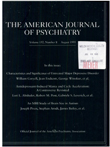The impact of mother-child interaction on the development of borderline personality disorder
Abstract
OBJECTIVE: Two major psychodynamic theories of the etiology of borderline personality disorder posit two aspects of mother-child interaction as uniquely pathogenic: maternal over-involvement with the child and mismanagement and inappropriateness of maternal guidance and support of the child. This study is an attempt to examine these putative risk factors empirically, using epidemiologic methods. METHOD: Mother-child interaction, father-child interaction, maternal personality, and adolescent diagnoses of personality disorders were measured on two occasions, 2.5 years apart, in a random sample of 776 adolescents. RESULTS: Maternal inconsistency in upbringing of the child predicted a persistence or an emergence of borderline personality disorder, but not of any other axis II disorder. However, this effect occurred only in the presence of high maternal overinvolvement. Neither maternal overinvolvement nor maternal inconsistency alone predicted emergence of borderline personality disorder. Pathological features of maternal personality did not account for the combined effect of maternal overinvolvement and inconsistency on borderline personality disorder. CONCLUSIONS: The two child-rearing risk factors hypothesized to be important by two psychodynamic models of borderline personality disorder were found to be pathogenic only when they coexisted. Their effect could not be accounted for by the biological or environmental vulnerability represented by maternal borderline personality traits.
Access content
To read the fulltext, please use one of the options below to sign in or purchase access.- Personal login
- Institutional Login
- Sign in via OpenAthens
- Register for access
-
Please login/register if you wish to pair your device and check access availability.
Not a subscriber?
PsychiatryOnline subscription options offer access to the DSM-5 library, books, journals, CME, and patient resources. This all-in-one virtual library provides psychiatrists and mental health professionals with key resources for diagnosis, treatment, research, and professional development.
Need more help? PsychiatryOnline Customer Service may be reached by emailing [email protected] or by calling 800-368-5777 (in the U.S.) or 703-907-7322 (outside the U.S.).



